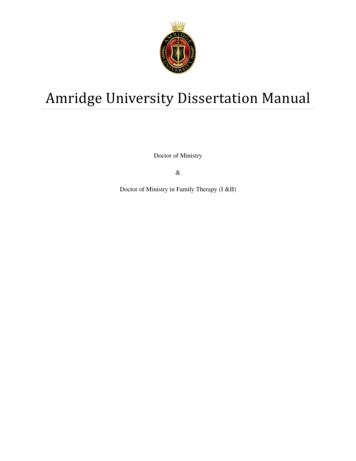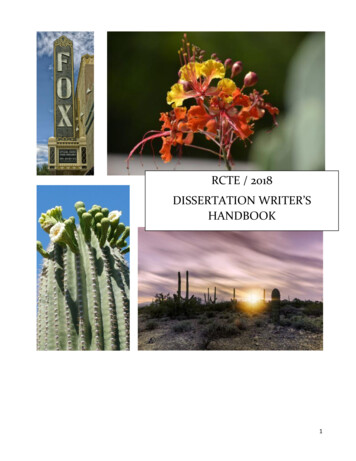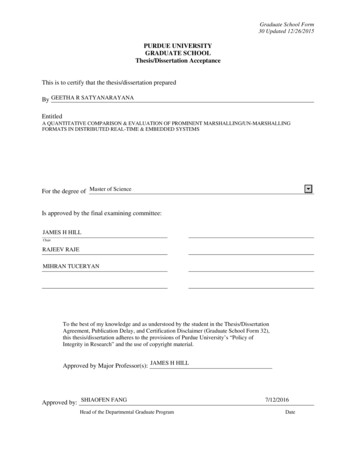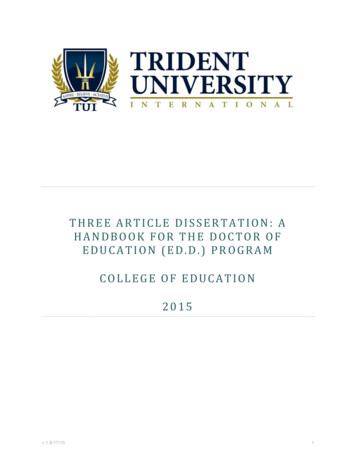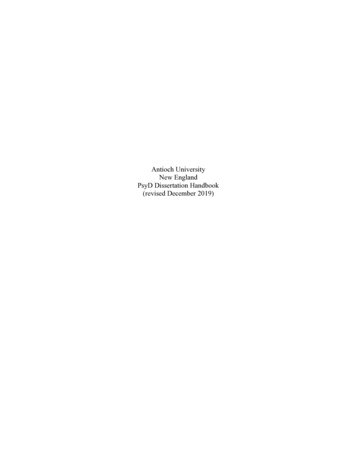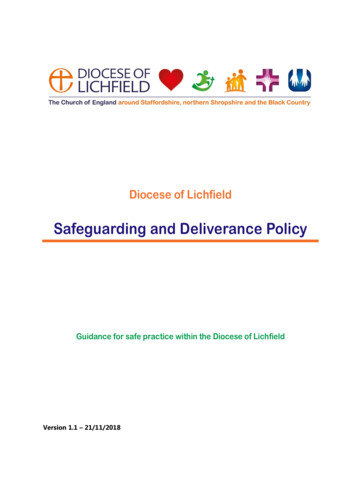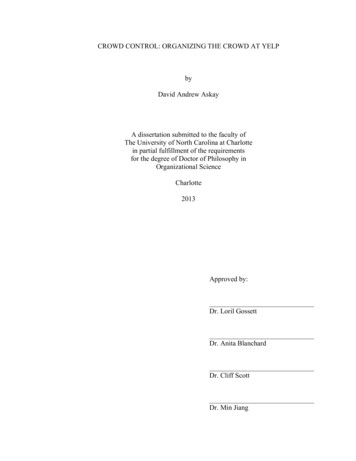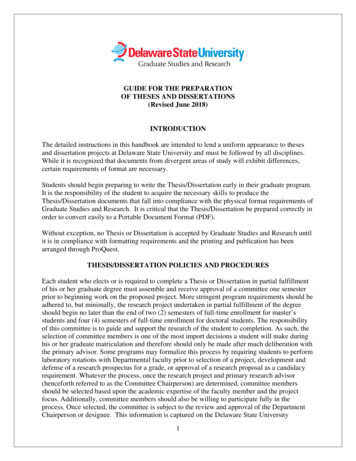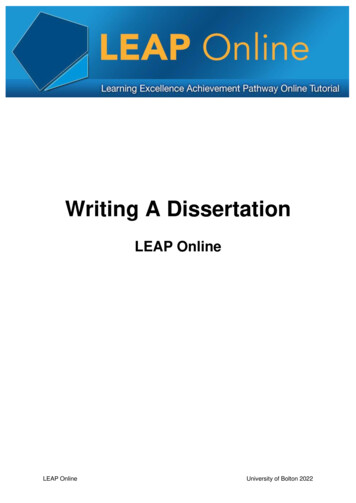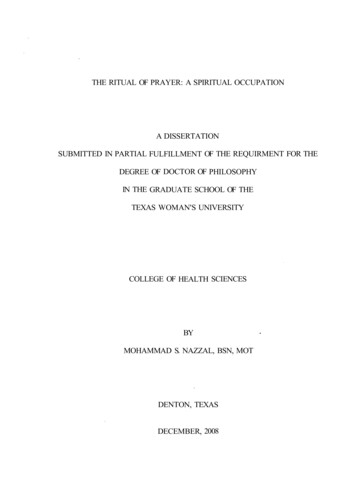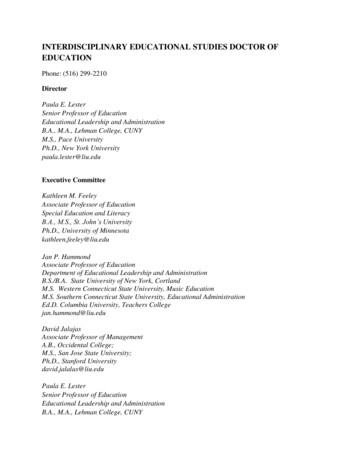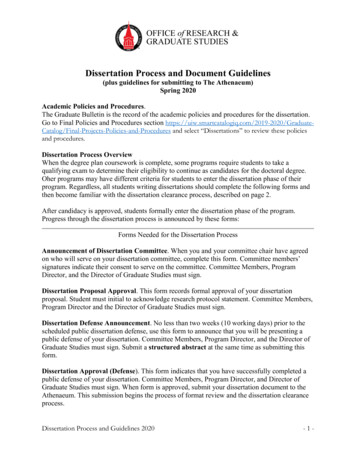
Transcription
Dissertation Process and Document Guidelines(plus guidelines for submitting to The Athenaeum)Spring 2020Academic Policies and Procedures.The Graduate Bulletin is the record of the academic policies and procedures for the dissertation.Go to Final Policies and Procedures section atalog/Final-Projects-Policies-and-Procedures and select “Dissertations” to review these policiesand procedures.Dissertation Process OverviewWhen the degree plan coursework is complete, some programs require students to take aqualifying exam to determine their eligibility to continue as candidates for the doctoral degree.Oher programs may have different criteria for students to enter the dissertation phase of theirprogram. Regardless, all students writing dissertations should complete the following forms andthen become familiar with the dissertation clearance process, described on page 2.After candidacy is approved, students formally enter the dissertation phase of the program.Progress through the dissertation process is announced by these forms:Forms Needed for the Dissertation ProcessAnnouncement of Dissertation Committee. When you and your committee chair have agreedon who will serve on your dissertation committee, complete this form. Committee members’signatures indicate their consent to serve on the committee. Committee Members, ProgramDirector, and the Director of Graduate Studies must sign.Dissertation Proposal Approval. This form records formal approval of your dissertationproposal. Student must initial to acknowledge research protocol statement. Committee Members,Program Director and the Director of Graduate Studies must sign.Dissertation Defense Announcement. No less than two weeks (10 working days) prior to thescheduled public dissertation defense, use this form to announce that you will be presenting apublic defense of your dissertation. Committee Members, Program Director, and the Director ofGraduate Studies must sign. Submit a structured abstract at the same time as submitting thisform.Dissertation Approval (Defense). This form indicates that you have successfully completed apublic defense of your dissertation. Committee Members, Program Director, and Director ofGraduate Studies must sign. When form is approved, submit your dissertation document to theAthenaeum. This submission begins the process of format review and the dissertation clearanceprocess.Dissertation Process and Guidelines 2020-1-
Dissertation Clearance ProcessThe dissertation clearance process confirms that the student has completed these steps: Account opened and dissertation uploaded to The Athenaeum; Survey of Earned Doctorates certificate of completion submitted; IRB protocols closed; Account opened and dissertation deposited in the UIW ProQuest ETD Administrator; Final format of dissertation approved.When these steps have been completed, a dissertation clearance form is sent for signature to theProgram Director and Director of Graduate Studies, and when complete is sent to the registrar toconfirm the completion by the student of all program and university requirements.Due DatesDissertations and all approval forms, except the clearance form, must be on file at the Office ofResearch and Graduate Studies by these dates:February 1June 1September 1May GraduationAugust GraduationDecember GraduationDissertations submitted after these dates may not be reviewed in time to clear the student toreceive the degree in the declared semester. If dissertation clearance cannot be granted until afterclose of the semester, then the Registrar may change the official degree posting date to the nextsemester.Plagiarism Check—SafeAssign: The dissertation will be submitted to SafeAssign for aplagiarism check and a SafeAssign Originality Report will be generated and filed with thestudent submission. Issues identified in the SafeAssign report, if any, will be included with theformat report generated for each student submission.Format Review ProcessThe dissertation is reviewed to check for adherence to UIW dissertation formatting standards asoutlined in this dissertation guide. This is not a content review, although word, sentence,paragraph level errors and punctuation errors will be marked if noted, especially if they affectmeaning or comprehension. The coordinator adds comments to the places in the document whererevision is needed and produces a format memo outlining major categories of revision workneeded. The marked up dissertation and format memo are returned to the student for furtheredits. Revised dissertations should be uploaded to the student’s account in the Athenaeum, andthe revised document is then checked again to ensure final format accuracy.Dissertation Process and Guidelines 2020-2-
How to Submit the Dissertation for Format ReviewThe submission process is entirely electronic. Print copies of the dissertation are not accepted.Follow these steps to submit your dissertation:1. Open an account at The Athenaeum at this URL: https://athenaeum.uiw.edu/. Completeall information prompts and upload a pdf copy of the dissertation. The systemautomatically notifies the dissertation coordinator that there is a new document ready forreview.2. Review by the dissertation coordinator may take up to three weeks, depending upon thenumber of other dissertations and theses. Format corrections can be time-consuming andinvolve much back-and-forth between the student and the dissertation coordinator.3. If the document is returned to the student for format corrections, a corrected copy must beuploaded to the account that was opened in The Athenaeum. Do not create a newaccount.4. After all format corrections have been completed by the student, the final, approved copywill be deposited into The Athenaeum and will become the permanent document ofrecord.5. Dissertation students also must deposit the approved, final copy of the dissertation intoProQuest Dissertations and Theses Global database using UIW’s ProQuest ETDAdministrator. The URL for the ETD administrator can be found here:https://www.etdadmin.com/main/home?siteId 617.Dissertation Document Guidelines—SummaryBefore submitting a dissertation to The Athenaeum—and to ProQuest—it must be formatted toUIW standards as stated in this manual. Students are entirely responsible for the dissertationcontent, citation integrity, writing mechanics, and correct formatting.All Pages Page numbers: Placed in upper right hand corner; use same font as body text . 12 point typeface, can be 10 pt. in tables and figures (if necessary). One inch margins all sides, all pages.Preliminary Pages Use provided templates.Dissertation Process and Guidelines 2020-3-
Chapter Pages Line spacing. Double space, except single spaceo in block quotes,o within table and figure notes,o within table titles and figure captions,o inside tables and figures (if necessary),o headings when more than one line, ando within reference entries. Figures and tables. Presented sequentially in the narrative and always preceded by amention. Headings. Format headings per APA guidelines. Chapter headings are level one. Levelone and two are always included in the table of contents. Including level three headingsin the table of contents is optional.Reference Section All reference entries must have a corresponding in-text citation, and vice-versa. All references are formatted exactly to the appropriate style specifications and all URLsare current. Use the “doi” (digital object identifier) whenever possible. Line spacing: Single space within entries, but double space between entries.Dissertation Document—Order of PagesPreliminary Pages (Use provided templates to ensure correct formatting.) Title Page Copyright Page Acknowledgments Dedication (optional) Abstract Table of Contents List of Tables (if tables are used in dissertation) List of Figures (if figures are used in dissertation) Other lists (if used in dissertation)Narrative Pages Preface (optional) All chapter pages References AppendicesDissertation Process and Guidelines 2020-4-
Dissertation Document Format Requirements—DetailedDissertation document format requirements combine UIW guidelines with those presented in thestyle manual required by the discipline or assigned by faculty supervisors.LanguageThe dissertation must be written in English.PunctuationPunctuation guidelines are based on standard U.S. English as used in the formal academiccontext. Detailed usage guidelines are presented in the relevant style manuals.One Space After Final Punctuation in a SentenceIt is perfectly acceptable to use two spaces after final punctuation in draft versions of thedissertation; however, it is essential to remove this double space before submitting for formatreview. Manuscripts showing more than a single space after final punctuation will be returnedfor correction.Typeface & Typeface SizeAny clear, easy-to-read 12 pt. font is acceptable, with Times New Roman used as the defaultchoice in many instances. Your dissertation chair or departmental guidelines may express a fontpreference. Whatever font is chosen, use that same font on all pages, including all body text,headings, page numbers, table titles, and figure captions. You may, however, use a differenteasy-to-read typeface, but no smaller than 10-point, inside tables and figures, in footnotes (ifused), and in materials incorporated in the appendices.Font StylesUse regular font throughout. Italic and bolded fonts may be used only as described in theguidelines of departmental style manual. Script, slanted font, and typefaces with characters ofdifferent sizes are not used except as needed in figures.Margins1 inch margins all sides, top, bottom, left, and right. Document headers and footers should be setto .5” (1/2 inch).Page NumberingNumber all pages consecutively in the upper right corner of the page. Assign a number to everypage of the document, although for certain pages the number is suppressed. Use the same font forpage numbers as used in the rest of the document. Do not embellish any numeral withpunctuation or other typographical symbols. Preliminary pages are numbered using lowercaseRoman numerals; the remainder of the text is numbered using Arabic numbers.Dissertation Process and Guidelines 2020-5-
Preliminary Pages. Use lower case Roman numerals (ii, iii, iv, etc.). The copyright pageis the first page to receive a number (ii). The title page number is counted in the pagecount but the number is always suppressed.Narrative Text, References, and Appendices. Place the page number in the upper rightcorner on all pages. Begin with page 1 immediately after the last preliminary page andcontinue in numerical order to the end of the document, including references andappendices. Landscape page numbers must be manually positioned so they are in thesame position as the numbers on the portrait pages. For instructions on placing pagenumbers to landscape oriented pages, open this browser link:http://support.microsoft.com/kb/211930/ .JustificationJustify only the left margin. Use a ragged (non-justified) right margin and allow all lines to wrapautomatically at the right margin. Do not divide words with a hyphen at the end of a line of text.Left justify all block quotes and any other text that is further indented from the left margin.Line SpacingPreliminary pages. Follow the special formatting requirements described in this manualfor each of the preliminary pages. Preliminary pages include all pages from the title pageup to, but not including, the body text.Narrative text. Double space throughout all chapters, and do not add extra spacebetween paragraphs. These elements are exceptions:Block quotes: Single space all block quotes.Table titles: Single space within the title when more than one line.Table notes: Single space when more than one line, but double space betweennotes.Figure titles or captions: Single space when more than one line.Headings: Single space when more than one line.References. Single space within reference entries and double space between entries.Appendices. Each appendix is formatted according to its source.Line Spacing for EquationsThe general rule is to leave ample space between the lines of the equation. Also, allow foradditional space above and below the equation to separate it from the text or another equation.Displayed equations should be adequately separated from the text so that they are well spaced onthe page.IndentingParagraphs. Indent the first line of all paragraphs about one half inch (½”), or about fivespaces. Use the tab key to set this indent; do not tap the space bar. All subsequent lines ofthe paragraph begin at the left margin unless a block quote.Block quotes. Quotations of at least 40 words, or more than three lines, must beformatted as block quotes. Indent all lines of block quotes ½” from the left margin andDissertation Process and Guidelines 2020-6-
place the entire quotation on the new, indented margin. Do not indent or justify the rightmargin of the block quote. Single space all lines. If the quotation is more than oneparagraph, indent the first line of this second paragraph (and any subsequent paragraphs)an additional ½ inch from the new margin.HeadingsHeadings applied in the body of the text are crucial guideposts for readers and reflect carefulorganization and logical development of the research project. The APA format preferences forheadings are illustrated here:APA Headings (6th edition)Centered, Boldface, Uppercase and LowercaseLeft-aligned, Bold, Uppercase and LowercaseIndented, bold, lowercase heading with a period. Begin body text after the period.Indented, bold and italic, lowercase heading with a period. Begin body text after theperiod.Indented, italic, lowercase heading with a period. Begin body text after the period.APA Headings (7th edition)Centered, Boldface, Uppercase and LowercaseLeft-aligned, Boldface, Uppercase and LowercaseLeft-aligned, Boldface, Uppercase and LowercaseIndented, Boldface, Uppercase and Lowercase Ending With a Period. Begin body textDo notan extra line space before or after headings.aftertheaddperiod.Indented,BoldAPAand Italic,LowercaseEndingofWitha Period.Begin bodyRegardlessof whetheror otherUppercasestylebook andis used,the appearancethe levelsof headingstextafterperiod. throughout the entire document.shouldbetheconsistentWhen subdividing a section, always advance directly to the next level of heading; do not skipany levels. When adding subheadings within a section, plan to create at least two subsections—or use none.Dissertation Process and Guidelines 2020-7-
In UIW formatting for dissertations, the level one heading as defined by this stylebook is thechapter heading; the level one heading is not used otherwise in the dissertation. (And, althoughdissertations are divided into chapters, it is not necessary to use the name “Chapter” to indicate achapter heading.)Heading levels one and two must be listed in the Table of Contents; in many cases it is alsoappropriate to include level three headings. The spelling and wording of the text headings andthose headings entered in the Table of Contents must match exactly, although because thepreliminary pages follow different formatting requirements, the formatting of headings ischanged when placed in the Table of Contents.Tables, Figures, and EquationsTables and Figures are used to identify tabular or graphic representations in the document. Whenused in chapter narrative, tables and figures must be presented in the preliminary pages as List ofTables, and List of Figures. See templates and guidelines for construction of List of Tables andList of Figures pages.If a table or figure is not referred to in the chapter narrative, do not include in the narrative;rather, such tables and figures are placed in the appendices and they are not identified in the Listof Tables or List of Figures.The APA manual presents detailed formatting guidelines for constructing tables and figures.Comprehensive table construction instructions are also available in Presenting Your Findings: APractical Guide for Creating Tables (6th ed.), published by the American PsychologicalAssociation.Using Copyrighted Material in a Table or Figure. If a table or figure, or information in a tableor figure, is copied or adapted from another source, place a copyright permission footnote in thetable or figure note in the form of a complete citation; such sources must also be cited in yourreferences/bibliography. Tables or figures may not be reproduced in whole from another sourcewithout express written permission from the author. Modifications, too, must often be used onlywith permission. This permission must be noted in the table or figure and the actual permissionletter is included as an appendix. For APA formatted documents, the procedure for indicatingsuch permissions is presented in table 12.1 of APA 7th edition, with examples shown in table12.2.Placement of Tables and Figures. Place tables and figures in the document as soon as possibleafter they are first referred to. However, the narrative may continue even if reference to anothertable or figure is made—the table or figure does not need to immediately follow. Two or moretables or figures can be placed sequentially in the document even if the narrative referencingthem is separated by several pages.If a page break is inserted in the text to allow for the placement of a table or figure on a separatepage, leaving a blank space on the bottom of the preceding page, fill that blank space with text.Dissertation Process and Guidelines 2020-8-
Text must be placed on table and figure pages if there is room for at least two lines of text. Donot wrap text around figures or tables.Spacing and format of all tables, figures, and equations should remain consistent throughout thedocument.Table definition. To be designated as a table, the information presented must be arranged inrows and columns (at least 2 of each). Table titles should precisely reflect the table’s content.The table should be designed to display information in a way that clarifies the textualdescription. Tables should be prepared in the following manner:Present the table as directly as possible after the first reference to it, but do not split a table if itcan fit on a single page. Rather than divide the table between pages, you may begin the table atthe top of the next page and fill the remainder of the previous page with narrative. Align alltables flush left with the margin.Table Number. Unless your stylebook prescribes otherwise, assign all tables a number,beginning with 1 (Table 1, Table 2, Table 3, and so on), and never mix with letters (Table 1a,Table 1b, Table 1c, and so on). Tables are numbered sequentially beginning with their firstappearance in the document (not per chapter). The table number is placed above and begins atthe table’s left margin. Do not use punctuation after the table number. The table number is alsoentered in the List of Tables.Table Title. Assign all tables a unique title. Be brief, but exact. The title is placed two linespaces below the table number and begins at the table’s left margin. The title is italicized and allmajor words are capitalized. Do not use punctuation after the table title.The table title does not extend beyond the table margins. Although longer titles are discouraged,if the title is longer than one line begin the next line a single line space (not double space)directly below the first line, and flush with the table’s left margin.List all table titles in the List of Tables. List only the table title and not any parenthetical wordsfollowing the title. The wording and punctuation of the title (but not the format) must exactlymatch the title in the List of Tables.Landscape Tables. A table can be set in the landscape position if necessary. The top of the tablein this case is parallel to the binding edge of the document, and so the first element below thatbinding edge would be the table number, followed by the table title, followed by the table andany table notes. See instructions under Page Numbering for placement of the page number.Horizontal Lines. Tables use only solid, unembellished, horizontal lines. Do not mix thin andthick lines. Use lines above and below column headings, below column spanners, and below thelast line of data on the last page of the table to denote completion of the table. Table lines mustDissertation Process and Guidelines 2020-9-
be separated from text above and below with sufficient space to ensure that the horizontal linedoes not become an underline.Color and Shading. Tables do not use color or shading.Table Notes. Tables can have three kinds of notes, general, specific and probability—this is theExample of tableTable 4Correlation of Ratings for Resort and Snow -.130-.091-.036.990**PowderNote. Table courtesy of Dr. Judith Beauford, Professor Emerita of Education, University of theIncarnate Word. Adapted from “Tables and Figures: A Picture is Worth a Thousand Words.”Copyright 2011 by Judith Beauford.*p .05, **p .01.APA preference. Table notes are unique to each table. Copyright permission footnotes for tablesare entered as general notes. Table notes are single spaced within a note, but place a doublespace between notes.Figure definition. A figure is any kind of visual presentation of information includingillustrations, photographs, graphs, drawings, diagrams, maps, and so on. As with tables, eachfigure must be precisely and uniquely titled. Figures, like tables, are referred to in text by theirfigure number, and every figure referred to must be listed in the List of Figures. Figures placedin the appendices do not need to be identified in the List of Figures and do not need to bereferenced in the text.Dissertation Process and Guidelines 2020- 10 -
Example of figure APA 6th ed.Figure 9. Adequacy of non-academic training on abuse.Example of figure APA 7th ed.Figure 9.Adequacy of Non-Academic Training on AbuseDissertation Process and Guidelines 2020- 11 -
Copyright Permission for Figures. Permission must always be obtained to use figures takenfrom another source, even if modified. The permission record must be noted in the figure notes(or caption) and the permission letter must be included as an appendix in the document.Figure Number. The figure number is entered in the List of Figures in the preliminary pagesAssign all figures a number, beginning with 1 (Figure 1., Figure 2., Figure 3., and so on), andnever mix with letters (Figure 1a, Figure 1b, Figure 1c, and so on). Figures are numberedsequentially beginning with their first appearance in the document. In APA 6th edition, the figurenumber is placed below the figure, begins flush with the figure’s left margin, is italicized, andends with a period (Figure 1., Figure 2., Figure 3., and so on). In APA 7th edition, format thefigure number exactly the same as the table number.Figure Caption. Figure captions (or titles) are entered in the List of Figures included with thepreliminary pages. For APA 6th edition guidelines, begin the figure caption on the same line asthe figure number and end it with a period, whether or not it is a complete sentence. For APA 7thedition guidelines, format the figure caption exactly the same as the table title. The caption ortitle should be concise, but complete enough to describe the figure. If using 6th edition, includein the caption explanations of units of measurement, symbols, acronyms, and abbreviations, ifthese are not explained in the figure legend; copyright permission footnotes and source notes arealso placed in the caption. If using APA 7th edition guidelines, these elements are included in afigure note, the same way as providing a table note.Color. Color may be used in any figure, depending on context and readability criteria.Facing Page Captions. This applies only if using APA 6th edition guidelines. Should there beno room on the figure page for a caption, the figure number and caption may be placed—centered—on the facing page, which is otherwise left blank. Captions on a facing page are to beused only when absolutely necessary. Facing page captions may be used for figures only, nevertables.Figure Legend. A legend explains the symbols used in the figure. The legend is placed insidethe figure and uses the same typeface as the rest of the figure.Landscape Figures. A figure can be set in the landscape position if necessary. The top of thefigure in this case is parallel to the binding edge of the document, and the figure number andcaption (or title) rotate along with the figure. The page number remains as if the page was in theusual or portrait position.Photographs. Photographs and other illustrative materials obtained from non-electronic sourcescan be scanned into electronic files for inclusion in the document and should be output into filesat a resolution setting of at least 300 dpi (dots per inch). Quality reproduction of halftonesDissertation Process and Guidelines 2020- 12 -
requires high-quality, high-contrast black-and-white originals. All photographs must observe thestandard document margins.Reductions. Tables, charts, figures, or other illustrative items that are reduced to fit within themargins must be large enough to be easily legible. The minimum size for numbers and capitalletters is 1.5 millimeters.Equations. Prepare and number equations according to the APA manual guidelines (pp. 123124). The formatting preference for simple equations is to continue them in the line of text.However, if equations extend above or below the line of text, set them off from the rest of thetext by placing them on their own line with a single space above and below. If these displayedequations are to be referred to later in the text then number them consecutively throughout thedocument, with the number placed in the right margin. Subsequent references to numberedequations in text are written out, for example, Equation 1, Equation 2, and so on. Since these areproper names, do not abbreviate or refer to in the ordinal form. A list of equations is notrequired.Samples of Equation. If the equation can go in line with the text, then place it here: 𝑎𝑎2 𝑏𝑏 2 𝑐𝑐 2 , as in this presentation of the Pythagorean Theorem. Otherwise, for equations that are betterpresented in a larger format, wider than one line of text, the standard format is to place theequation like this,(𝑥𝑥 𝑎𝑎)𝑛𝑛 𝑛𝑛 𝑛𝑛𝑘𝑘 𝑥𝑥 𝑘𝑘 𝑎𝑎𝑛𝑛 𝑘𝑘𝑘𝑘 01with the punctuation preceding the equation determining how text begins on the line immediatelyafter the equation. The equation number is placed on the right margin.ReferencesThe references/bibliography section follows directly after the final chapter page. Format the titleof this section in title case, but do not bold. Reference entries are formatted hanging indent style;use the paragraph formatting function to format reference entries (do not use the tab button toindent). All references are single spaced, but add a double space between entries. All publishedmaterial and any other sources mentioned in the text must be included, with the exception ofpersonal communications.AppendicesThe appendices section follows directly after the final references section page. If there is onlyone Appendix, it can simply be labeled Appendix (accompanied by the appendix title). Whenincluding multiple appendices, use the heading APPENDICES in your Table of Contents.Appendices should be prepared in the following manner:Dissertation Process and Guidelines 2020- 13 -
1. If there is only one appendix, simply insert the page or pages of that appendiximmediately after the final references page, and label the first appendix page Appendix.Do not add a letter as there is only one appendix.2. If there is more than one appendix to be included, insert a page after the end of thereferences section and place the title “Appendices,” centered on the page. This title isformatted in title case and is not bolded. Include this page in the total page count, butsuppress the page number. Your appendices pages will follow this separator page.3. At the top of the following pages, place the heading Appendix A (B, C, etc.), for each ofthe appendices. Each appendix page heading is located at the top of the page, andcentered. Following the heading place the title of the Appendix, and use the same format.Double-space titles requiring more than one line.4. The page number style and location of each appendix is to be consistent with the pagenumbering system used in the body of the document. Every page in each appendix,including photocopied material, must have a page number.5. All inserted appendix material must stay within the one inch document margins and somay be reduced if necessary. The typeface may vary from that of the text if reproducedmaterial.6. Materials in the appendices must be reproduced on one side of the page only.Appendices may include detailed statistical data, questionnaires, form letters, results of pilotstudies, figures, or tables providing supplementary information. Do not include letters anddocuments from individuals or institutions that may reveal the identity of confidential subjects,or take care to remove or completely block out identifying information when including suchmaterials. If the student’s research involved protected subjects or materials such as thoseregulated by the University’s Human Subjects Institutional Review Board, the InstitutionalAnimal Care and Use Committee, or the Institutional Biosafety Committee, a copy of the signedletter of research protocol clearance must be included as an appendix.No copyrighted material in excess of “fair use” may appear in the appendices without the expresswritten consent of the copyright holder. Any material that might exceed generally accepted fairuse guidelines must be accompanied by a letter from the copyright holder granting the authorpermission to reproduce (not just use) the materia
o within reference entries. Figures and tables. Presented sequentially in the narrative and always preceded by a mention. Headings. Format headings per APA guidelines. Chapter headings are level one. Level one and two are always included in the table of contents. Including level three headings in the table of contents is optional.
